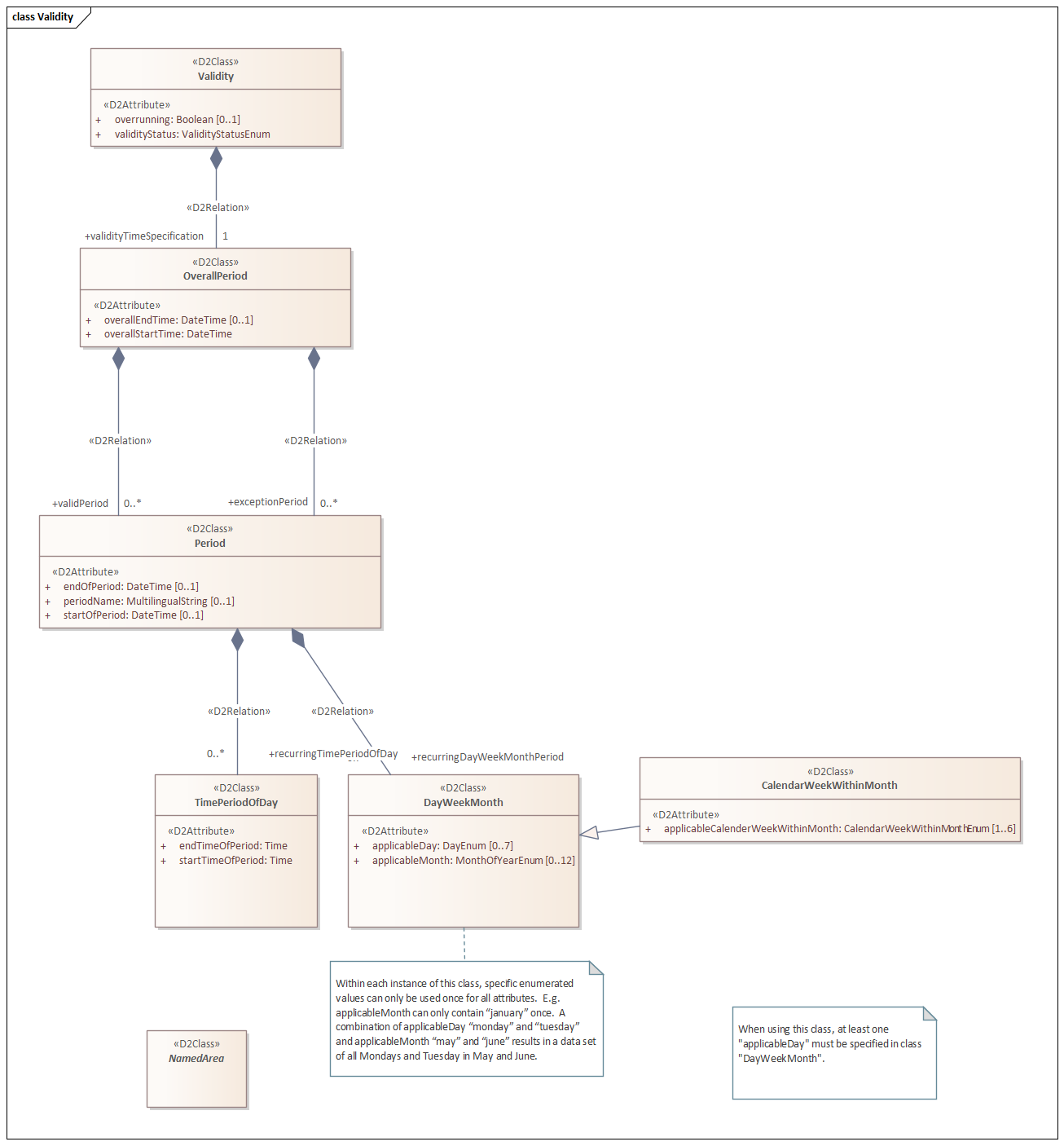Element validity
Information about validity is included in the mandatory element validity. Validity is defined as "the situation component is active, visible on the road, etc.". For example, with announced roadworks, it can be derived when the works will occur. The structure of the element is as follows:
Subelements
Element validityStatus
This element describes how the validity of the situation component is determined. In the Dutch profile of DATEX II, it is agreed that validity is always derived from the content of validityTimeSpecification.
Note
In the Dutch profile, it has been agreed that validity is always derived from the content of validityTimeSpecification.
| Type: | Mandatory | Domain |
|---|---|---|
| ValidityStatusEnum | Yes | definedByValidityTimeSpec |
Element overrunning
This element indicates that a component is still valid/active, even though a previously announced end time has already passed. This element must be used if applicable, otherwise it should not be used.
| Type: | Mandatory | Domain |
|---|---|---|
| Boolean | Yes or not used | true |
Element validityTimeSpecification
The element validityTimeSpecification specifies the period during which the situation component is valid. This is done using several sub-elements.
Elements
Element overallStartTime
This element specifies the first time that the entire situation component becomes or has become valid.
| Type: | Mandatory | Domain |
|---|---|---|
| DateTime | Yes | Date and time in UTC (Zulu notation) |
Element overallEndTime
The element overallEndTime specifies the last time that the situation component becomes invalid. If this element is omitted, the end time is unknown.
Note
In some cases, the overallEndTime is set to 24 hours after the overallStartTime.
| Type: | Mandatory | Domain |
|---|---|---|
| DateTime | No | Date and time in UTC (Zulu notation) |
Element validPeriod
The situation component does not have to be valid for the entire period between overallStartTime and overallEndTime. For example, in the case of recurring work, all periods during which the work actually takes place will be included. In such a case, one or more validPeriod elements are used to restrict the validity period. In practice, this is rarely used in this way but is theoretically possible.
The elements validPeriod and exceptionPeriod cannot be used together. Therefore, only one of the two will appear. Some sub-elements are mandatory. The validPeriod element must contain at least one of the sub-elements.
Subelementen validPeriod
Element startOfPeriod
This element specifies the start of a period during which the component becomes or has become valid (validPeriod) or the start of the period when the component is excluded (exceptionPeriod). If this element is omitted, the value of overallStartTime is used as the start time for the period described by this validPeriod.
| Type: | Mandatory | Domain |
|---|---|---|
| DateTime | No | Date and time in UTC (Zulu notation) |
Element EndOfPeriod
This element specifies the end of a period during which the situation component is valid (validPeriod) or the end of the period during which the component is excluded (exceptionPeriod). If this element is omitted, the period ends at the time specified by overallEndTime. If this time is also not specified, the end time is unknown. This cannot occur with exceptionPeriod, which must have a defined end time.
| Type: | Mandatory | Domain |
|---|---|---|
| DateTime | See above | Date and time in UTC (Zulu notation) |
Element periodName
If systems are unable to express the period in defined times, text descriptions can be used. The use of this element is discouraged since it cannot be processed automatically.
| Type: | Mandatory | Domain |
|---|---|---|
| MultilingualString | No | N/A |
Binnen validPeriod en exceptionPeriod is het ook mogelijke om vaste terugkeerpatronen vast te leggen.
Element exceptionPeriod
The situation component does not have to be valid for the entire period between overallStartTime and overallEndTime. Using the exceptionPeriod element, one or more periods between overallStartTime and overallEndTime can be excluded.
Warning
The use of exceptionPeriod is discouraged. Its semantic meaning is that the status is in rest/inactive during the time interval defined by the exceptionPeriod.
The elements exceptionPeriod and validPeriod cannot be used together. Therefore, only one of the two will appear.
The elements used are identical to those under validPeriod.
Voorbeeld
<sit:validity>
<com:validityStatus>definedByValidityTimeSpec</com:validityStatus>
<com:validityTimeSpecification>
<com:overallStartTime>2024-08-07T08:00:00Z</com:overallStartTime>
<com:overallEndTime>2024-08-10T17:00:00Z</com:overallEndTime>
<com:validPeriod>
<com:startOfPeriod>2024-08-07T08:00:00Z</com:startOfPeriod>
<com:endOfPeriod>2024-08-08T17:00:00Z</com:endOfPeriod>
</com:validPeriod>
<com:validPeriod>
<com:startOfPeriod>2024-08-09T08:00:00Z</com:startOfPeriod>
<com:endOfPeriod>2024-08-09T17:00:00Z</com:endOfPeriod>
</com:validPeriod>
<com:validPeriod>
<com:startOfPeriod>2024-08-10T08:00:00Z</com:startOfPeriod>
<com:endOfPeriod>2024-08-10T17:00:00Z</com:endOfPeriod>
</com:validPeriod>
</com:validityTimeSpecification>
</sit:validity>
